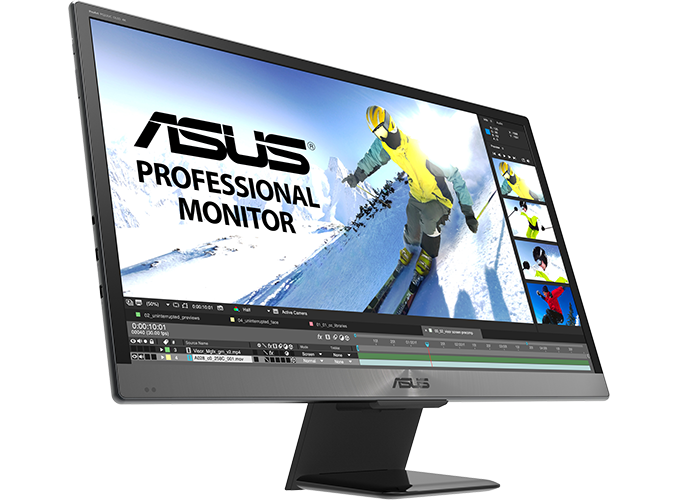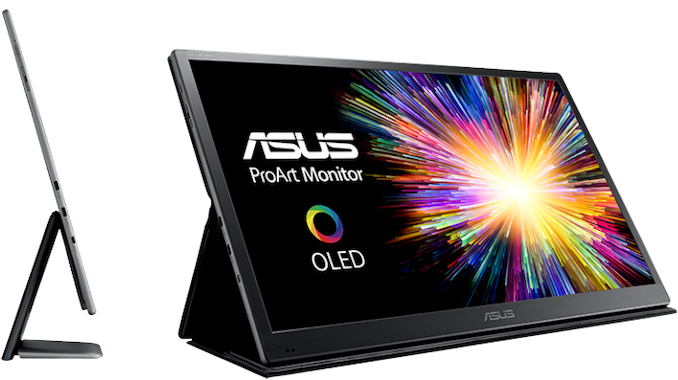ASUS ProArt PQ22UC 4K OLED Monitor: £4699, ~$5150
by Anton Shilov on March 22, 2019 5:00 PM EST
ASUS announced its first professional OLED display back at CES 2018 over a year ago. The compact and lightweight 21.6-inch 4K monitor covering 99% of the DCI-P3 color aimed at professionals attracted a lot of attention from various parties, but it has taken ASUS quite some time to perfect the product. Only this month the company began to sell the display on select markets with broader availability expected going forward. Meanwhile, the price of the monitor looks rather overwhelming.
The ASUS ProArt PQ22UC features a 21.6-inch 4K RGB stripe OLED panel produced by JOLED using its printing method. The panel supports a 3840×2160 resolution, 140 - 330 nits brightness (typical/peak), a contrast ratio of 1,000,000:1, and a response time of 0.1 ms. The monitor features an internal 14-bit 3D LUT (lookup table), can reproduce 1.07 billion colors, and comes factory-calibrated to a Delta E <2 accuracy. The ProArt PQ22UC is said to feature a 95% uniformity compensation to avoid fluctuations in brightness and chromaticity on different parts of the screen. ASUS says that it can cover 99% of the DCI-P3 color space (without specifying whitepoint chromacity) and supports HDR10 as well as HLG formats for high dynamic range content. Meanwhile, ASUS yet has to reveal which other modes the display supports (e.g., REC2020, REC709, etc.).
Besides very accurate colors and a very high contrast ratio, the main features of the ProArt PQ22UC are its compact dimensions, a foldable stand, a foldable protection case, as well as a low weight (about a kilogram or so with the stand). To further save space and make the product thinner, ASUS equipped the the ProArt PQ22UC with two USB Type-C and micro-HDMI inputs (no word on exact protocols, but DP 1.2 and HDMI 2.0x are likely). The compact dimensions and weight enable owners to easily carry it around, which is particularly important for people who need to do post-production outside of their studios as well as various on-set routines. ASUS does not ship the monitor with a light-shielding hood, a common accessory for displays used for cinematography and color-critical workloads, due to its portability.
| Brief Specifications of the ASUS ProArt PQ22UC | |
| PQ22UC | |
| Panel | 21.6" OLED |
| Native Resolution | 3840 × 2160 |
| Maximum Refresh Rate | 60 Hz |
| Response Time | 0.1 ms (black to white) |
| Brightness | minimum: 0.0005 cd/m² typical: 140 cd/m² maximum: 330 cd/m² |
| Contrast | 1,000,000:1 |
| Viewing Angles | 178°/178° horizontal/vertical |
| Pixel Pitch | 0.1245 mm² |
| Pixel Density | 204 ppi |
| Display Colors | 1.07 billion |
| Color Gamut Support | DCI-P3: 99% sRGB/Rec 709: 100% (tbc) Adobe RGB: ? SMPTE C: ? Rec2020: ? |
| Stand | Tilt and height adjustable |
| Inputs | 2 × USB Type-C (DP 1.2?) 1 × mini HDMI (2.0a? 2.0b?) |
| PSU | External |
| Launch Price & Date | Spring 2019 €5000 ~ $5000 |
The ASUS ProArt PQ22UC display is now available from select stores in Austria and the UK for €5,160 and £4,699 with taxes. TFTCentral claims that broader availability is expected in April, but the official price for the UK will be £4,799 with taxes. If we roughly subtract the UK sales tax from the current retail price and convert the sum to US Dollars, we will get something like $5150, which means that the product will likely carry a ~$5000 MSRP in the US.
Related Reading:
- ASUS Unveils ProArt PQ22UC OLED Monitor: 4K, 99% DCI-P3, 0.1 ms Response Time
- JOLED Demos 21.6-Inch OLED Monitor for Gamers
- Dell at CES 2019: Alienware 55-Inch 4K 120 Hz OLED Gaming Monitor Showcased
- New 8K OLED Displays for Tablets and Laptops: 8.3 and 13.3 Inches
Sources: TFT Central, AVMagazine











87 Comments
View All Comments
jrs77 - Friday, March 22, 2019 - link
Awesome display, but a bit pricey.Frenetic Pony - Friday, March 22, 2019 - link
$5k is a BIT? Doesn't even conform to any HDR brightness standard, which is what any artist paying for an HDR monitor would require.What a stupid thing.
quiksilvr - Friday, March 22, 2019 - link
I have to agree. Considering that OLED 4K TVs cost about 1/3 of this and are much larger the price does not make much sense. It isn't even higher refresh rate, G-SYNC or DisplayHDR certified like their own PG27UQ. The response time of this OLED is pretty sick though.caqde - Friday, March 22, 2019 - link
Well considering the OLED DisplayHDR certification was only recently introduced in January. It is not surprising this monitor has not gone through the certification process since Display HDR 400/600/1000 are only for LCD panels.https://www.anandtech.com/show/13756/vesa-rolls-ou...
bug77 - Saturday, March 23, 2019 - link
It's not because the standard is recent, it's because this monitor doesn't meet it. The lower standard, DisplayHDR 400 TrueBlack requires 250cd/sqm for full screen and 400cd/sqm for local flashes. This monitor only does 140 and 330.It's the age-old problem of OLED and burn in when you crank up the brightness.
lilkwarrior - Sunday, August 18, 2019 - link
VESA HDR standards have nothing to do w/ OLED screens. You need to grade this monitor along VESA TrueBlack standards.Also nits is not at all the primary thing to look for w/ HDR. It's something that's been overrated by LCD manufacturers for some time against superior panel tech such as OLED in marketing.
A Dolby Vision OLED monitor such as this ones absolutely destroys almost every LCD HDR 1000 panel; you'd have to start comparing it to $30,000+ FALD LCD panels to start seeing contenders even for this panel.
dropme - Saturday, March 23, 2019 - link
https://www.anandtech.com/show/13896/samsung-unvei...At least Samsung's meets the standard (if we believe what they're saying)
Santoval - Saturday, March 23, 2019 - link
"The response time of this OLED is pretty sick though."That is not something unique with that display or due to it being a professional monitor. ~0.1 ms response times are typical for OLED panels. OLED is simply super fast at that.
Brett Howse - Sunday, March 24, 2019 - link
4K OLED TVs are not RGB OLED but W-OLED which is why they are significantly less money:https://www.anandtech.com/show/13054/at-101-unders...
eastcoast_pete - Monday, March 25, 2019 - link
Thanks Brett! I also asked Anton, but maybe you can answer it, too: Are these RGB OLED monitors significantly more resistant to burn-in than W-OLED displays? I love the color depth and blacks of OLED displays, but have shied away from them for use as monitors. Given the price of the ASUS, I wouldn't touch them unless they are fully warrantied against burn-in for at least 3 years.